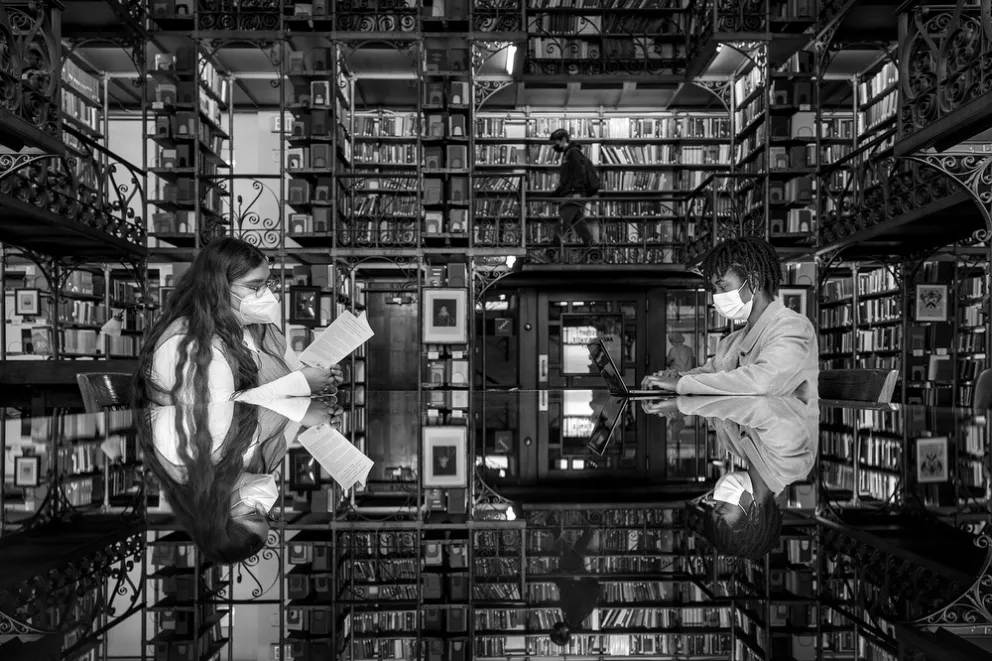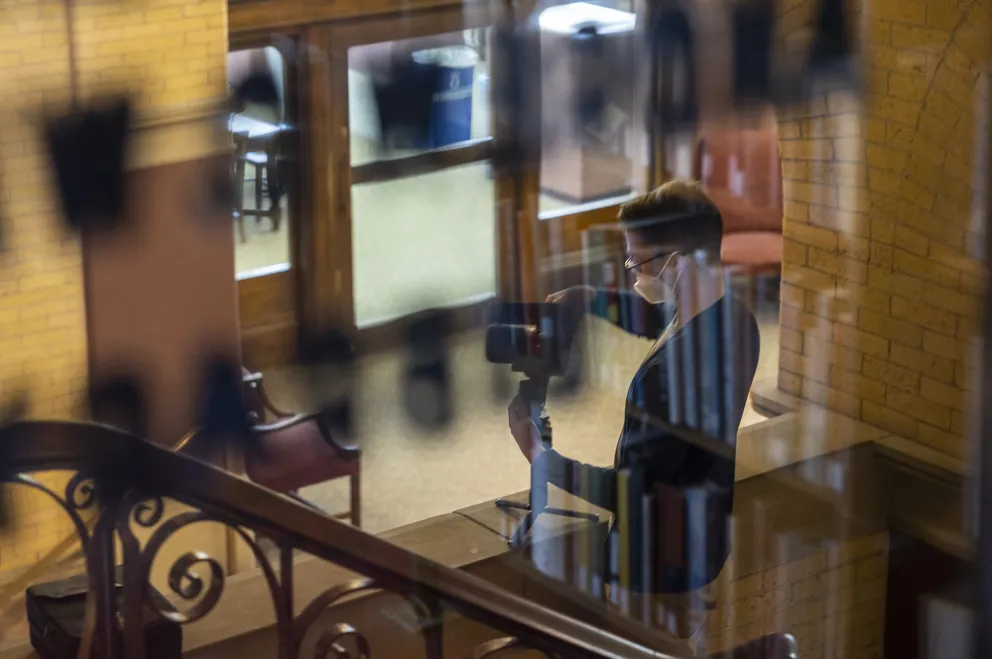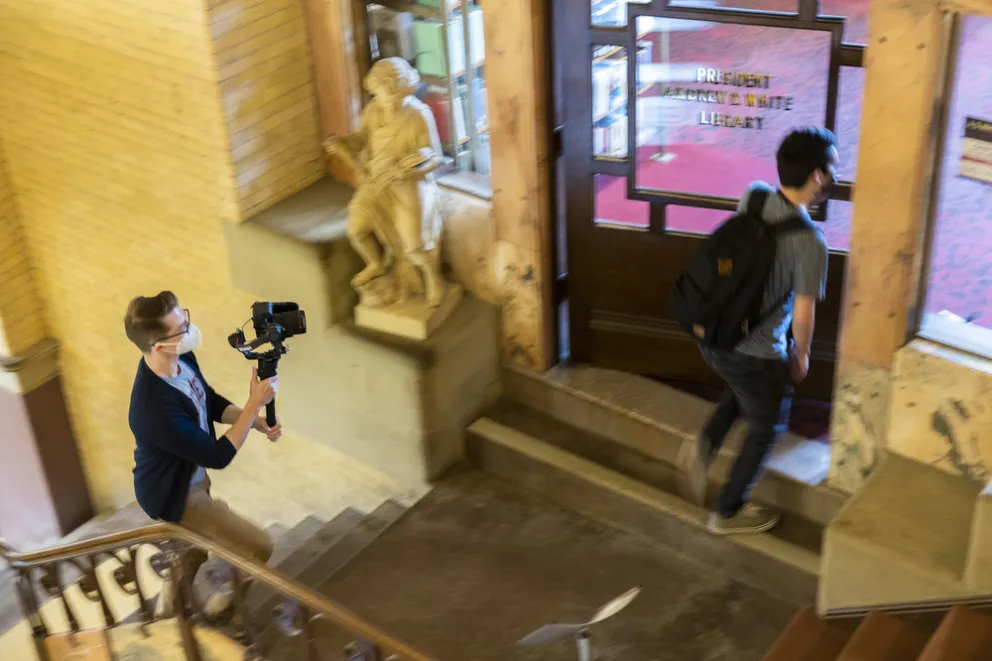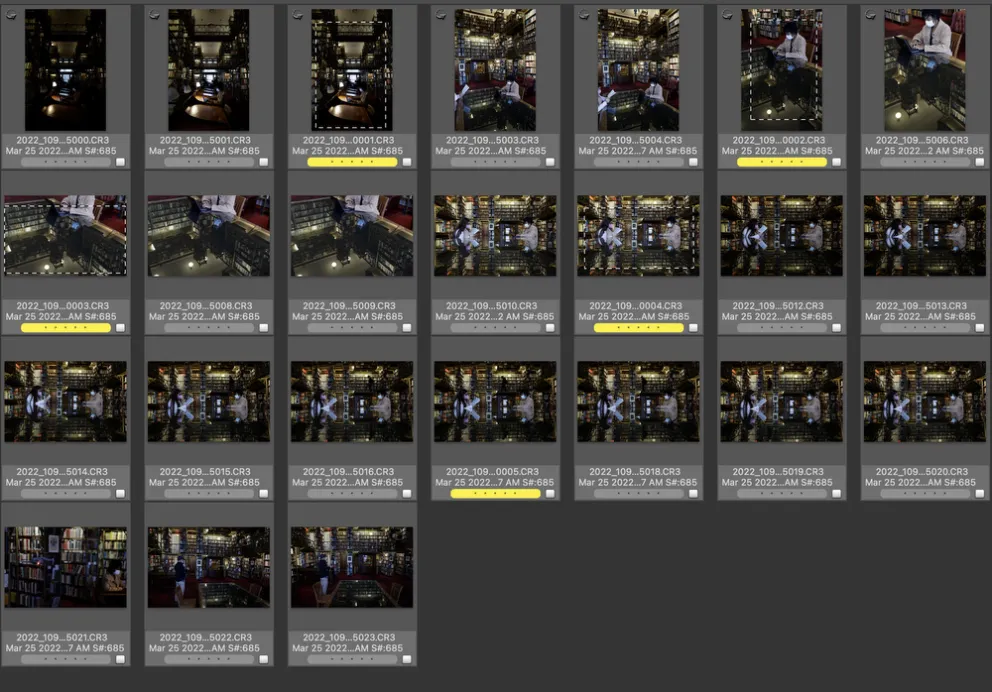
UPAA Blog 2021-22 #18 - 5/5/22 (photos and text by Ryan Young)
The MIC Q&A is a monthly feature on the UPAA Blog to take a deeper dive into the technique and thought behind UPAA's contest-winning images. Ryan Young's Campus Environment category image "Harry Potter Library" was voted Best in Show in the April 2022 Monthly Image Competition.
Ryan takes it from here, italics and all! -Ed.
************
Hi all! This is my first time writing in the blog, so here’s my condensed bio: My name’s Ryan Young, I’m a multimedia producer here at Cornell, and much like Odysseus, I too have had a long strange journey that lead me to Ithaca (though mine involved fewer Cyclops and Sirens...) (Sick mythology reference, this dude must be cool!)
I studied photojournalism at Ohio University and graduated in 2012. Since then I’ve had staff jobs with regional magazines, newspapers, nonprofits, professional sports leagues, and even spent a little time freelancing - all before turning 30! In 2019 I made the jump to higher ed when I took a visual content creator role at Virginia Tech, and in the fall of 2021 I joined Cornell’s wonderful team here in Ithaca. So while I’m still getting my bearings in Upstate New York, I have been loving it so far.
I think this is my first full year of involvement with UPAA, but it’s been a great resource and community, especially for someone who is still relatively new to the higher ed photo world.
1. Quick tech stuff: Camera, lens, lighting (if any):
•Canon R6
•24-70mm @ 24mm
•1/80 f2.8 ISO 1000
2. How did this shoot land on your calendar? Did you have a plan/vision prior to the shoot?
This shoot was part of a series produced for Instagram Reels called “Cornell Moments” that highlight unique and iconic aspects of life at Cornell. Our team has produced some of these short videos on everything from the clocktower chimes to the campus greenhouses to our hockey teams. It’s been a great way to explore the iconography of Cornell in a purely visceral manner, without having to worry too much about a narrative other than “hey, this is cool, take a look.”
One of everyone’s favorite spots on campus is the A.D. White Library. It was designed by Cornell’s first architecture student, William Henry Miller, to house the book collection of our co-founder and first president, A.D. White. Its whimsical Victorian era design has earned it the nickname the “Harry Potter Library” amongst students. So it made sense to include this iconic space in the series.
When I was growing up one of my first “dream jobs” was to be an architect - before I learned that unfortunately there is a lot of math involved in architecture, thus excluding me and my inability to do anything beyond basic arithmetic. But I’ve still maintained an interest in that sort of stuff (ask me about my big urban design reading kick (Wow, this guy really * is * cool)) so I jumped at the opportunity to head up this project when our social team threw it out as a potential subject.
My initial concept for this video was kind of experimental and complex. I ran that idea, or the idea of doing something a little more straightforward, by our social team and they liked the idea of going the more straightforward route. I think this was helpful both in terms of the final product, and because it allowed me to have the opportunity to squeeze off a few still frames as well. Otherwise had I been trying to execute a more conceptual video I would have had much less bandwidth to think about stills.

Even though stills were very much an afterthought for this project, it was still on my mind. Unfortunately we don’t always get this sort of access to shoot in the A.D. White Library, but since it is such an iconic spot on campus any images that we do get while we’re allowed in usually end up getting a ton of use for years to come.
So as far as a vision for the photography portion of this shoot goes, I was keeping my eyes peeled for atmospheric shots that would highlight the unique aspects of the space in a manner that’s visually creative, but not so abstract that we end up losing a sense of place.
3. Any unique logistics in making the photo? What sort of post processing (or not)?
This shoot was pretty complicated from a logistical standpoint. Our university’s library staff understandably wants to make sure that the students using the facilities aren’t disturbed while they’re studying, so we worked out a time when we could use the library shortly after it had closed on Friday night. (Just to clarify, it's not necessarily that our access to the libraries on campus is restricted per se. But when it comes to this library specifically it is actually a relatively small room and is very, very quiet -- like "feel like a jerk for coughing" quiet -- so if we were running around with a couple of cameras going up to every other person asking if we could film them studying it would definitely be a distraction. So in the interest of respecting our students' peace and quiet and staying in the good graces of our partners in the libraries it made sense to schedule a specific time when we wouldn't be bothering anyone on a shoot like this.)
Secondly, since it was after hours on a Friday, and we wanted to be respectful of everyone’s time, we only had an hour to film. Also because we didn’t want the room to look empty we sent out a call for students to volunteer as “actors” to play the role of studying students. I was initially hoping to get at least 5-10 students to help us out with this.
And finally, keeping in mind that this was primarily a video shoot that was being produced for a vertical medium (IG Reels) I was planning on using our DJI Ronin S2 set up in vertical mode. It was the first time I had tried using this gimbal in that capacity.
When we arrived on Friday night we found out that we only had 3 students show up, we had a small communication mix-up with our library staffers that ended up cutting into our shooting time, and by the time we actually got rolling my gimbal freaked out on me, forcing me to abandon it and start shooting handheld. (Something, something, best laid plans of mice and men…)

Ryan and the misbehaving gimbal
Fortunately, I was lucky enough to have my colleague, Jason, helping out as a second shooter on this project which really made a world of difference in ensuring that we were able to get everything we needed in the short amount of time we had, and also freeing me up to squeeze off a couple of still images.
4. Did your vision before you made the photo come through in the final product? What (if anything) would you do differently if you could re-shoot this today?
I definitely didn’t have this exact photo in mind before the shoot. I had been in this room a handful of times, but had never stood behind this table or noticed it’s glass top. And of course like any other self-respecting photographer, I’m a sucker for any sort of shiny reflective surface, so as soon as I saw that I immediately honed in on it.
All in all I only ended up taking 21 still images (take THAT, old-photo-editor-who-always-used-to-harrang-me-for-shooting-too-heavy!) and you can see in my take that I basically saw this one image, worked the scene until I got a couple frames that I liked, and then hopped right back into video mode. I think this image does achieve the sort of abstract, nebulous goal that I had in my mind at the beginning.

I don’t think I’d really do anything different with this particular photo, but I would love to revisit this scene and try out some different things like photographing it on a sunny day with light streaking in through the windows, shooting with an even wider lens, etc. But hey, that’s one of the great things about being a photographer in higher ed, right? You can usually go back to the same spot and try it again year after year.
5. What do you do to keep yourself motivated and interested in your work?
I’ll be honest, when I was starting out in higher ed a few years ago I had gotten to a point where I was feeling pretty lukewarm on photography and was even starting to learn the first steps of the old “well maybe I should go to grad school and make a career change” dance.
Of course throughout the years I’ve had to suffer my share of the arrows that are often directed at us as photographer (low pay, inconsistent hours, etc, etc.) - but there was something else about my career that really left me wanting. Call it boredom, call it burnout, call it ennui. I dunno. But for much of my professional career, I just wasn’t getting excited about photography the way I had when I was a college student studying photojournalism.
However, when I started working for Virginia Tech it was the first time that I was being asked to really produce video consistently. (I had studied video production in college but never got to practice it much in the real world.) This new storytelling avenue turned out to be exactly the bolt of lightning that I needed to re-spark my interest in my work. In the three years since I started doing video regularly I feel more creative, confident and purposeful in my work. And feeling better about my work holistically has definitely helped my still photography narrowly.
I always have and I always will love still photography, but for a long time it felt like I was playing solitaire with half a deck of cards. Now it feels like I’m performing magic tricks on stage in Vegas. (Illusions, Dad! You don’t have time for my illusions!)

Two of Ryan's 1st place Campus Environment images from 2021-22.
I could go on for days about the fluid nature of art and information in the digital age and how balancing multiple objectives and ideas for a shoot is a skill in and of itself. But, I guess part of the reason why I’ve gone off on this tangent in the first place is because I see so many photographers kvetching about being asked to shoot video and all I want to do is highlight that it is possible to do both - at the same time - at a pretty high level. Of course, your mileage may vary when it comes to pursuing other mediums. Some people just aren't into video or motion graphics or GIFs or whatever. That's totally fine. But I guess at the end of the day what I'm trying to say is that I've personally benefitted a ton from branching out and I hope that other people in our field can start to look at crossing that photo-video divide not as a burden, but instead as an opportunity to pursue a whole new world of creative possibilities.
(Sir, this is a Wendy’s)
************
"Can anyone tell me what 'oblivious' means? I have no idea." Thanks for reading the blog. Article submissions or suggestions are always welcome. Email editor Matt Cashore, mcashore@nd.edu. And, as always, if you don't already, follow UPAA on Instagram!